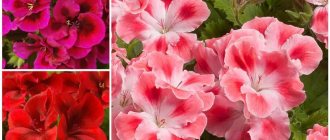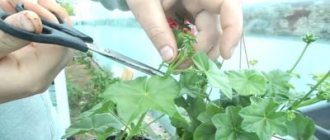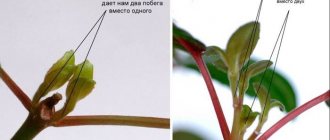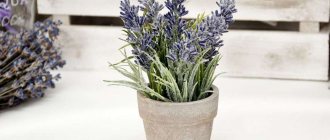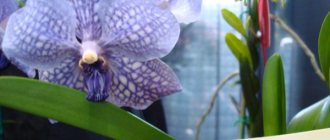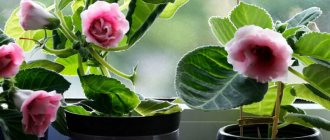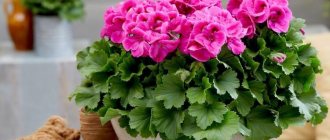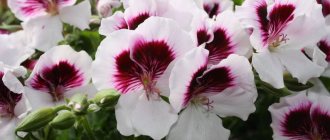Bright, lush flowering most of the year, a tart, bitter-floral aroma, unpretentiousness of the plant - thanks to these qualities, geranium has firmly become one of the most beloved indoor plants in the world. In today's review we will talk about the basic rules for caring for this flower at different times of the year, how to propagate and replant it correctly, as well as what diseases you may encounter and for what reasons.
Geranium flowers come in many colors
Geranium or pelargonium - who is it and where does it come from?
Geranium (pelargonium) is an unpretentious, herbaceous or semi-shrub flower brought from Africa in the 17th century. Based on the data in the Latin (geranium) and ancient Greek dictionaries (γεράνιον), it can be understood that the name of the plant was given based on the external resemblance of the shape of the fruit to a crane’s beak.
The geranium group consists of 400 varieties. Although Africa is the birthplace of the houseplant geranium, pelargonium has become widespread on almost all continents due to its bright, voluminous flowers and general decorative qualities. Interest in some varieties of pelargonium is due not only to the external characteristics of the flower, as can be seen in the photo, but also to its medicinal properties.
The first mentions of indoor geranium in Russia date back to the middle of the 18th century.
Types of indoor geraniums: photos and names
What do different varieties of geranium look like? For ease of perception, we have placed the types of indoor geraniums along with photos and names in the table:
| Types of indoor geraniums, name | Peculiarity | Photo |
| Zonal | A wide variety of colors, long-term flowering, height from 14 cm to 70 cm. | |
| Royal | Large flowers with grooved or wavy petals, spots or stripes. It blooms in the second year, flowering duration is 4 months. Height – up to 15 cm. | |
| Fragrant | A large number of different flavors (apple, nutmeg, kiwi, almond, etc.). Terry foliage, carved along the edges. Color: pink or purple. | |
| Ivy-leaved | Ampelous, shoots up to 1 m. Leaves look like ivy. Color: from white to black-blue. Flowers are up to 5 cm in diameter. | |
| Unique | Dark green with a spicy aroma, dissected foliage. The flowers are similar to royal geraniums. Color: red with white center of the inflorescence. Pink or white coloring is less common. | |
| Angel | Externally, the inflorescences resemble “Pansies”. Height - up to 35 cm. Long-term flowering. Color: white, pink, purple, lilac (with stripes or spots). | |
| Succulent (can be cortus-leaved, humpbacked, fluffy-leaved, fleshy, angular, thick-stemmed) | An exotic variety of pelargonium. Bizarre plant shape, woody stem below. Some subspecies have spines. Sensitive to dry air and frequency of watering. |
Types and varieties of geraniums (pelargoniums)
There are 280 species of pelargonium in the world (1), but only a few are used in indoor culture.
zonale . She is bordered pelargonium. This type is most often found in apartments. It got its name due to the color of the leaves - they have a darker, often brown stripe along the edge. The leaves are pubescent, with a strong odor. The flowers are collected in large umbrella inflorescences.
Pelargonium is zonal. Photo: pixabay.com
This pelargonium comes from South Africa. It came to Europe at the end of the 17th century and was very popular there for a long time. And so much so that at some point it became a symbol of bourgeois tastelessness. This plant reached Russia only a century later - at the turn of the 18th - 19th centuries. And at first, the beautiful geranium grew exclusively in aristocratic houses. But later everyone began to grow it without exception.
Currently, this pelargonium has more than 10,000 varieties. According to the modern classification proposed by the owner of the English national collection of pelargoniums Fibrex Hasel Kay, zonal pelargoniums are divided into several groups:
- non-double - they have simple flowers with 5 petals arranged in 1 row;
- terry - this includes semi-double varieties with 6 - 8 petals, terry, which have more than 8 petals, as well as tulip-shaped, in which the flowers are semi-double, but they never open - they remain in buds, reminiscent of tulip buds;
- Rosaceae (rosaceae) - with densely double flowers, similar to half-open roses;
- star-shaped (stellar) - their flowers are shaped like stars;
- cactus-shaped - their flowers have long petals, which are sometimes curled into a tube and resemble some cactus flowers;
- variegated (variegated) - they have variegated leaves of various shapes and colors;
- miniature - form very small bushes;
- dwarf - combines all low-growing varieties.
The most interesting and unusual varieties of zonal pelargonium:
- Appleblossom Rosebud - with densely double white, pink-shaped flowers with a pink border and a green center;
- Chelsea Morning - with large snow-white flowers, which have a bright crimson spot at the base of each petal;
- Deacon Peacock - with double orange-red flowers and green-gold foliage with a bronze edge;
- Doreen - with large double peach-pink flowers, which have a white border along the edge of the petals and dark pink veins in the center;
- Icecrystal - with pink-lilac flowers, which have a fuchsia-colored spot at the base of each petal;
- Golden Choice - with dense pink flowers and golden foliage with a red-brown border;
- Green and Gold Petit Pierre - a stunning variety with light green leaves, which has a green spot in the center, bright pink flowers with long petals;
- Joy - with large double flowers of a very unusual color - they are creamy white with a soft pink border along the edge of the petals;
- June Patricia - star-shaped pelargonium with double flowers of orange-red color, with golden leaves;
- Plum Rambler - with densely double flowers of a rose-shaped dark red color with a white underside at the petals.
Ivy-leaved pelargonium (Pelargonium peltatum). Another popular pelargonium and also native to South Africa. People often call it ampelous geranium. It is a trailing plant, but when planted in a hanging pot, it hangs over the edges impressively. The leaves of this pelargonium are glossy, the flowers are collected in umbrella inflorescences and can be of a wide variety of colors.
Pelargonium ivy-leaved. Photo: A. Jagel, globallookpress.com
Among the varieties, the most spectacular ones can be identified:
- Great Balls of Fire Violet Blue - with large semi-double flowers of rich lilac color with crimson veins in the center;
- Great Balls of Fire Merlot - with huge caps of double, rich cherry flowers;
- Temprano Orchid - with double salmon-colored flowers.
Large-flowered pelargonium (Pelargonium grandiflorum). Flower growers often call it the royal geranium. This is one of the most spectacular species - the inflorescences can reach a diameter of 15 cm, and the flowers bloom almost continuously from May to October. They have a variety of colors, there are two-color varieties. This pelargonium also comes from South Africa.
Pelargonium grandiflora. Photo: pixabay.com
She has interesting variety series. For example, Angel are hybrids obtained from crossing large-flowered pelargonium and curly pelargonium (Pelargonium crispum). Their flowers resemble those of violets or bright butterflies. And the leaves smell like lemon. Here are the most popular ones:
- Angel Tip Top Duet - 30 - 40 cm high, the upper petals of the flowers are dark crimson with burgundy veins, the lower ones are pale lilac;
- Angeleyes Bicolor - two-color color: the upper petals are crimson and the lower petals are white;
- Angeleyes Angel Mosquitaway lizzy - with white flowers and a burgundy spot in the center, leaves with a strong lemon aroma.
- Angeleyes Angel Randy - up to 40 cm high with small flowers, up to 2 cm in diameter, light pink in color with a crimson spot and a white edging along the edge of the petals, with a slight aroma of the leaves;
- Wayward Angel - with light lilac flowers with crimson spots on the upper petals.
Another popular variety series is Aristo. It was bred in Germany and is distinguished by its compact bush size and large inflorescences that bloom for 3 months in a row. The most popular varieties:
- Aristo Black Beauty - with burgundy-purple flowers;
- Aristo Candy - the upper petals are purple with a lilac border, the lower petals are lavender with fuchsia spots;
- Aristo Petticoat - lower petals are pure white, upper petals are white with a bright burgundy spot.
Pelargonium grandiflora has several more interesting varieties that are also worth paying attention to:
- Birthday Gir - bright pink flowers with a white base and ruffled edges of the petals;
- Fairy Queen - with large flowers: the upper ones are dark purple with a white edge, the lower ones are white with purple spots and streaks;
- Mona Lisa - with large white and pink flowers and a crimson spot at the base of the petals.
Pelargonium fragrant.
Photo: F. Hecker, globallookpress.com graveolens . This is the same “grandmother’s flower” that grew on the windows of many apartments in Soviet times. Its flowers are not as spectacular as those of other species, but it is not valued for them either. The leaves are what attracts gardeners. They are carved, velvety and very aromatic - with a distinct hint of lemon.
The best conditions for growing indoor geraniums
Caring for geraniums at home is simple: it is better to choose a sunny place for indoor geraniums, on the south side. At midday, it is better to shade the plant or place the pot so that the flower is not in direct sunlight all day.
Despite the unpretentiousness of the flower, none of the varieties of homemade geranium will tolerate neglect of the watering regime. All types of pelargonium react the same way to excess moisture: sluggish appearance, the appearance of mold, blackening of the stems. The earthen ball should be kept in a moderately moist state. However, geranium does not like spraying the leaves.
The photo shows that pelargoniums of any variety and name feel great in an apartment. In the summer-spring period, the plant is transferred to an open balcony or street.
Geranium indoors
The nuances of growing geraniums at home:
- if you pinch the tops of the stems in a timely manner, you can form a compact, abundantly flowering bush;
- removing dried inflorescences allows new ones to form faster;
- It is better not to add organic fertilizers. This is a catalyst for green growth, and you can’t wait for flowering. An excess of organic matter will destroy geraniums ;
- in a cramped pot the plant blooms more actively.
For the winter, geraniums are brought back into the apartment.
How to care for geraniums in spring, summer and autumn: differences
In spring , starting from mid-March, geraniums are abundantly overgrown with greenery and bloom. During this period, mineral supplements are administered once every two weeks, starting with a small dose. In the spring, young foliage appears en masse on geraniums, so it is recommended to first shade the flower from direct sunlight. In mid-May, the plant can be taken out to an open loggia or to the yard.
In summer, care boils down to regular watering, fertilizing once every two weeks, removing faded inflorescences, pinching or pruning geraniums. During prolonged rains, pelargoniums taken outside are either brought indoors or covered.
Caring for geraniums at home at any time of the year is simple, even for beginners. In autumn, flowers are brought into the house. In central Russia, this is the end of September in the absence of early frosts. The first thing you need to do is reduce the frequency of watering. The earthen ball should not be too dry; water it little by little and regularly. The main task of autumn is to prepare pelargonium for wintering. Fertilize plants once every three weeks, in winter - once a month. The geranium itself will begin to bloom less, losing its decorative effect. This is a signal to the grower that the plant is preparing for the last pre-winter pruning. Cut branches can be used for rooting and propagation.
Lighting in the autumn-winter period can not be changed, leaving the flower on the south side. The temperature should not fall below 12 degrees Celsius, the optimal winter temperature is 15 degrees, since the plant needs a period of rest.
By following these simple techniques, you will no longer wonder how to preserve geraniums at home in winter.
Geranium at home
Advice from flower growers
To achieve beautiful buds, you need to know the “character” of geranium. She loves light, so keep the beauty on southern windowsills. And during the flowering period, it’s a good idea to turn on the lighting.
You also need to be careful with watering. The plant is rather drought-resistant. Excess moisture in the pot can cause the roots to rot. Watering is carried out as the top layer of soil dries.
Warmth is required to set flower stalks. The room temperature should not fall below 13-15⁰С. Timely pruning will also allow you to admire the colorful chorus of buds.
Garden world
The host of the “Garden World” program spoke about some more secrets of cuttings, as well as replanting geraniums when spring comes.
- The stem, which has become very elongated after winter, must be divided into several parts.
- Prepare a container for planting. First add drainage, 2-3 cm, then a layer of soil.
- The cuttings, which have been left for 2-3 hours to be covered with film, are planted immediately in the ground, powdering the cut with Kornevin or Kornerost. You don't need a lot of preparation, just powder it.
- Planting: make a hole, deepen the cutting, press down the soil, water with water with Fitosporin.
- Place a bag on top and tie it around the pot to create a greenhouse. There is no need to water frequently; the cuttings will take root well under the greenhouse effect under the film.
The main stem can also be transplanted into another pot by following all planting recommendations. To activate it for lush flowering, you need to make cuts above the bud. This stimulation will help the dormant buds begin to grow.
How to propagate geranium
There are only two ways to propagate pelargonium: propagation by cuttings and seeds. The differences lie in the fact that when propagated by cuttings, the species characteristic of the variety is preserved, but when propagated by seeds, there is a possibility of obtaining a plant that differs in appearance from the desired one. The second method is best used by professional flower growers.
We propagate indoor geraniums by cuttings
Cuttings can be carried out from spring to autumn; the most successful time for rooting will be mid or late winter. By this time, pruned in the fall, the bush is overgrown with numerous branches. The upper parts of the branches are cut off with a sharp, disinfected knife and lowered into the water. A warm temperature is required. While the mother plant is gaining strength, the cuttings develop roots.
For successful rooting, take a loose substrate. Take the twigs with roots out of the water, dry them in the open air for half an hour and carefully place them in a small hole in a pot that has been spilled with water in advance. It is not necessary to cover the cuttings with a cap from a transparent bag; geranium is not picky and will quickly grow.
Propagation by cuttings
We propagate homemade geraniums by seeds
If you want to get geranium from seeds, you need to prepare the soil. Preparation comes down to the following steps:
- make soil : mix loose substrate with a small amount of humus and sand;
- disinfect the soil with a faint pink raster of potassium permanganate;
- spray the soil with warm water from a spray bottle;
- distribute the seeds evenly and gently press them shallowly into the soil with your finger;
- cover the containers with transparent material or glass.
As soon as the first shoots appear, the film begins to be gradually removed, 15 minutes in the morning and evening. The first waterings are done very carefully; it is better to use a spray bottle. Pelargoniums will grow very quickly; when the first true leaf appears, the film is removed and watering is carried out at the root. When a pair of true leaves appears, the plants are planted in different pots.
Further care for geraniums is carried out according to general rules.
Propagation by seeds
Reproduction by cuttings
You need to start propagating by cuttings in February - March. You can use cut parts of the bush just for this. Take a sharp knife and treat it with alcohol. You need to cut at right angles to the main stem. There should be at least 3 leaves on the cutting, but you need to remove everything except the top one and one more. It is also mandatory to remove buds and flowers, if any. The cut material is placed in a dark container with water in a bright place. The water needs to be changed every 2 days. Depending on the variety of geranium, cuttings will take root from 2 to 6 weeks. Rooting in water is not suitable for all varieties; in some, rotting will begin even before the roots grow. Rooting in the ground is suitable for them. In this case, the cut is treated with activated carbon powder and the cutting is immediately planted in the soil.
As soon as the plant grows a little, you need to cut off its top, then you will get a lush, beautiful bush, and not a lonely elongated stick with leaves.
We create comfortable conditions for geranium flowering
Everything you need to follow is very easy to remember. Lush flowering when caring for pelargonium at home is guaranteed with a combination of temperature conditions, regular watering, selected soil and good lighting.
Selecting the soil
The soil selected is light. Adding equal parts of humus and sand is welcome. The following proportions will be successful: 7 parts of turf or garden soil, 2 parts of humus, 1 part of sand or 8:1:1. Drainage is required; expanded clay or pieces of foam are suitable for this.
Soil for geraniums
Light for geraniums
Since the flowering time is a long period, from spring to late autumn, or even the beginning of winter, all attention should be focused on illumination. Geranium loves light. Accordingly, choose a sunny place. On the street, the best location would be a sunny area with natural daytime shading. The north side of the house will not work!
What is the best way to feed geraniums?
Watering should be strictly regular; you should not overwater the soil, but drought will also have a detrimental effect on flowering. The water should be at room temperature in any case. The plant needs to be fed once every two weeks. A compound mineral fertilizer is suitable for flowering plants.
ATTENTION!
No organics!
Temperature
During the flowering period, the most optimal temperature is considered to be from +20 to +30 degrees. When the temperature drops, flowering is reduced; when the temperature is too high, the flowers become smaller and fall off.
How to prune geraniums for lush blooms
Indoor geraniums should be pruned twice - in spring and autumn. But the main one is spring pruning, before the growing season begins.
Spring pruning
Experienced gardeners advise pruning early. It is believed that this is the best start for the lush flowering of your favorite flower.
Pruning a flower in spring is a mandatory procedure.
- Remove all frail, very elongated shoots, leaving 2-3 “live” buds. Before the first inflorescences appear, long shoots should be pinched.
- To prevent the bush from stretching, it is pinched, making it impossible to stretch upward. The top is removed so that the side shoots can begin to grow in the spring.
- By regularly removing the tops, you can achieve a beautiful spherical crown.
- A distinctive feature of this type of flower is the presence of “sleeping” buds. How to wake up frozen kidneys? The pruning procedure in the spring will awaken them so that they can produce young shoots.
- Closer to spring, you can transplant by cuttings.
Do not prune cuttings before February. In winter there is not enough light, the plant will stretch out and become ugly.
Autumn pruning
In order for a geranium to be fluffy, it needs the right haircut. Pruning is carried out in autumn and spring. In winter, she rests so that she can delight with lush buds for a long time.
The purpose of autumn pruning is to prepare for dormancy. Usually the bush is cut to a “stump”, leaving 2-3 dormant buds, so that a neat young bush will grow later. If shoots are needed for propagation in spring, then to a height of 10-15 cm.
A plant pruned in autumn will withstand the winter better.
Autumn pruning is carried out after the last inflorescence has withered, approximately in the 2-3rd decade of October. After this process, the bush can be rejuvenated. All old shoots must be cut off.
Care during the resting stage is not difficult. From November to February, the flower does not need to be fed, and it does not particularly need watering. You can’t leave it completely without water either. Watering is allowed rare and not abundant.
Forming a geranium bush: pruning for lush flowering
If we let the growth of pelargonium take its course, we will get long, unkempt branches with a small number of flowers. To prevent such sloppiness, gardeners carry out formative pruning.
How to prune geraniums correctly: first of all, disinfect a sharp knife or blade to avoid infection of the flower. After carefully examining the plant, remove diseased or thin branches. Among the remaining ones, those that thicken the bush are removed.
Using a knife or blade, cut off part of the branch above the leaf node. If the leaf faces the inside, it is better to choose another one, this way we will avoid the appearance of branches thickening the crown. It is permissible to pinch thin branches with your fingers.
All cuts are sprinkled with crushed charcoal or cinnamon powder.
Geranium pruning
How to replant geraniums: tips
Geraniums are replanted in the following cases:
- roots are peeking out of the drainage hole;
- the plant does not bloom, despite intensive care;
- the soil dries out too quickly, which means the pot has become cramped.
If the previous container has become cramped, take a new one only 2-3 cm larger. Wash the pot with bleach for disinfection, dry it and fill the bottom with drainage. Add some fresh soil. To extract, water the soil and gently knock on the walls of the pot. So, the earthen lump gathers around the roots and lags behind the walls of the pot. Carefully inspect the roots; cut off damaged ones with a clean knife. An earthen ball with a flower is lowered into a new pot, the space is tightly filled with new soil. Now you need to water the plant generously and put it in the shade for 5-7 days.
DO NOT FORGET!
A freshly transplanted plant does not need feeding for 2 months!
Geranium transplantation process
Features of caring for geraniums after pruning
The cut sections must be sprinkled with crushed coal, cinnamon or lubricated with brilliant green. A trimmed bush stands almost without leaves, and many gardeners want to water it abundantly, believing that this way it will begin to grow better. This is mistake.
In spring, it is important not to overwater the seedlings, because the flower still has nothing to evaporate moisture.
How do you know when to water? The soil should dry out by about 1-1.5 cm, then you can water it.
But now we need more light. Place the pots on the brightest windowsill.
Cuttings with roots transplanted into fresh soil can be fed at the root after 3-4 weeks. If you are leaving an old bush, you can apply fertilizer immediately after pruning. To gain green mass, nitrogen is needed.
When the leaves appear, calcium nitrate will be used. It contains calcium and 14.9% nitrogen. It is necessary to spray the leaf with the following solution: dilute 1 g of saltpeter in 1 liter of water and spray.
After a month, you can water it with complex mineral fertilizer, specially prepared for flowering plantings.
What can geranium cause and how to treat it?
Despite its high resistance to diseases, geranium is affected by gray mold, root collar rot and is attacked by aphids and scale insects.
In case of gray rot, the plant is transferred to dry mode and treated with an antifungal drug. It is unlikely that the plant can be saved from root rot. They fight against aphids and scale insects using quarantine regime insecticides (to avoid the transmission of pests to other flowers).
How to get rid of midges in indoor flowers using simple methods. In a special publication on our portal, we will talk in detail about how to get rid of midges on indoor flowers, why they appear, how to avoid their appearance and preventive measures.
What to do: geranium leaves are turning yellow
The first reason is the incorrect concentration of fertilizers, namely an excess of nitrogen. For some time, the plant should be left alone and stop fertilizing.
The second reason may be a pot that is disproportionate to the plant. Try replanting the plant in a smaller pot.
Why doesn't geranium bloom?
There may be several reasons. The most important thing is a lack of nutrients. It will be replenished with complete flower fertilizer. The second common reason is considered to be lack of lighting. Try moving the plant to the sunniest spot in the house.
If the plant is often overdried, then it may not bloom at all.
Geranium bush without flowers
Why does geranium dry out?
The flower may dry out if the pot is too small. Transfer the plant to a larger pot.
The second reason is the proximity to the battery in winter.
Drying geranium
If geranium leaves turn red
There are three reasons: lack of magnesium, low temperature, fungal diseases.
We will compensate for the lack of magnesium with fertilizer, and if we suspect a disease, we spray the geranium with a fungicide.
Blushed geranium
Photos of royal pelargonium and tips for care at home
This variety of geraniums is the most capricious. To achieve lush flowering of the royal geranium as in the photo, you need to know what it doesn’t like:
- compaction of the soil is unacceptable. Therefore, we water only with warm, settled water through a pan;
- the drainage layer should be larger than that of other pelargoniums;
- in summer, the queen should not be taken outside , it is better to leave her on a glassed-in loggia. In case of strong wind or rain, windows should be closed;
- royal pelargonium does not need annual replanting , only when roots appear from the drainage hole;
- In winter, the temperature must not exceed 15 degrees!
So, caring for royal geraniums at home is not much more difficult than caring for other types of this flower.
